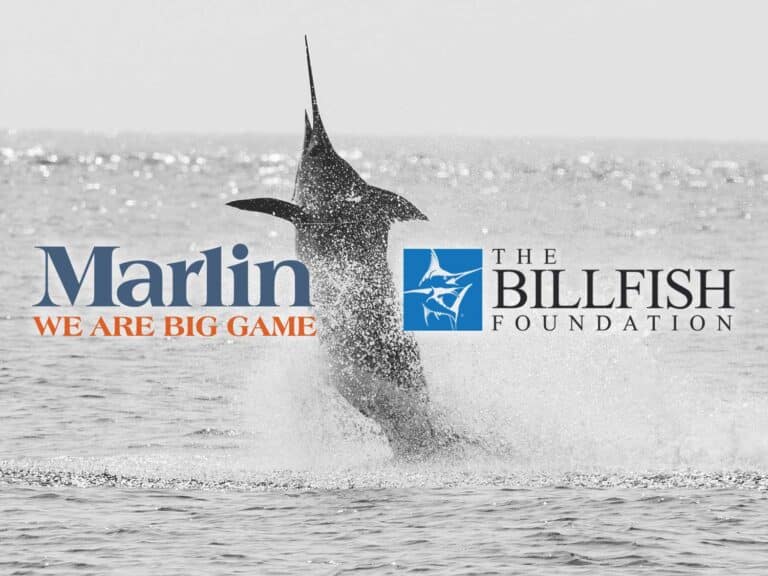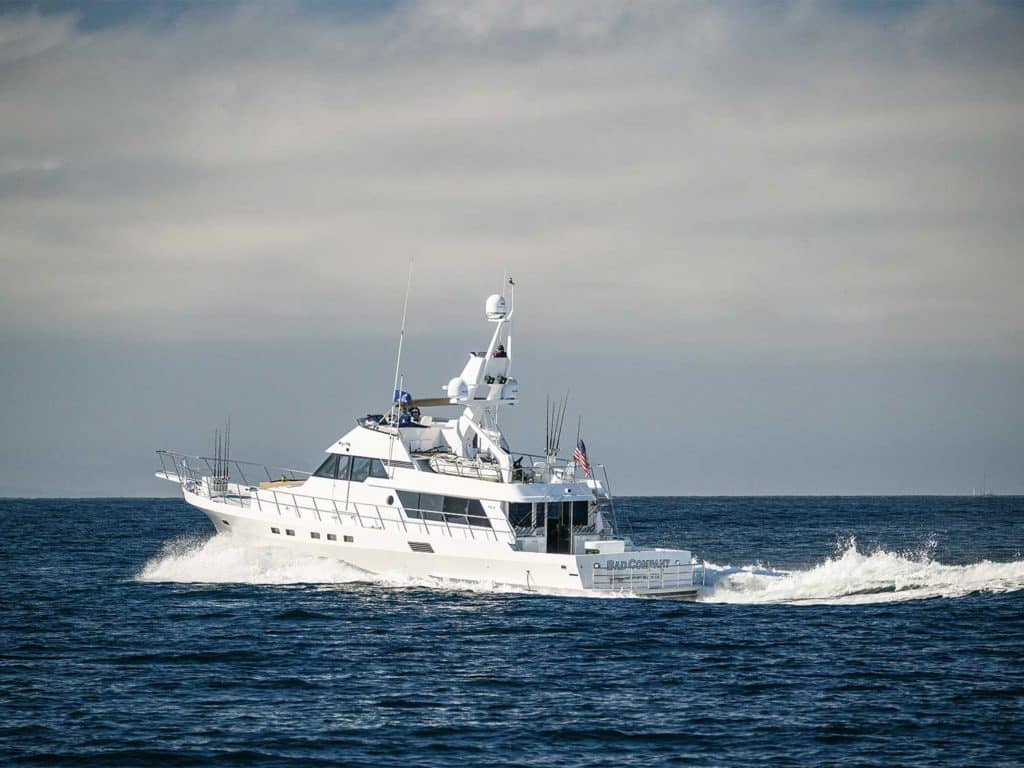
Four sets of eyes scanned the ocean on the Golden Gate Bank, northwest of Cabo San Lucas, Mexico. We had been fishing for only about 20 minutes when Capt. Steve Lassley yelled from the bridge of the recently refitted 92-foot Jones-Goodell yacht-fisher: “Fish, 2 o’clock, 2 inches, 20 boats!”—captain-speak for spotting a striped marlin’s position, with just the tail 2 inches out of the water, at a distance of about 600 yards. It had been 30 years since I’d sight-fished along Mexico’s western coast, but the thrill was still the same. I missed Cabo, and I couldn’t pass up the opportunity to fish with one of the most successful billfishing teams in the world. The Bad Company program is full of complicated components, yet the display of seamless teamwork is a result of respect and friendship—and we all could use a little more of that.
Bad Company owner Anthony Hsieh (pronounced shay) grabbed a rod and retrieved a mackerel from one of the bow-mounted livewells, making an underhand cast to the tailing fish. The water swirled as the striped marlin turned on the bait. Hsieh gingerly fed the stripey until the fish turned and started swimming away from the boat. Less than five minutes later, the striped marlin was released, hardly aware that it had even been caught. No harm, no foul, and a released fish.
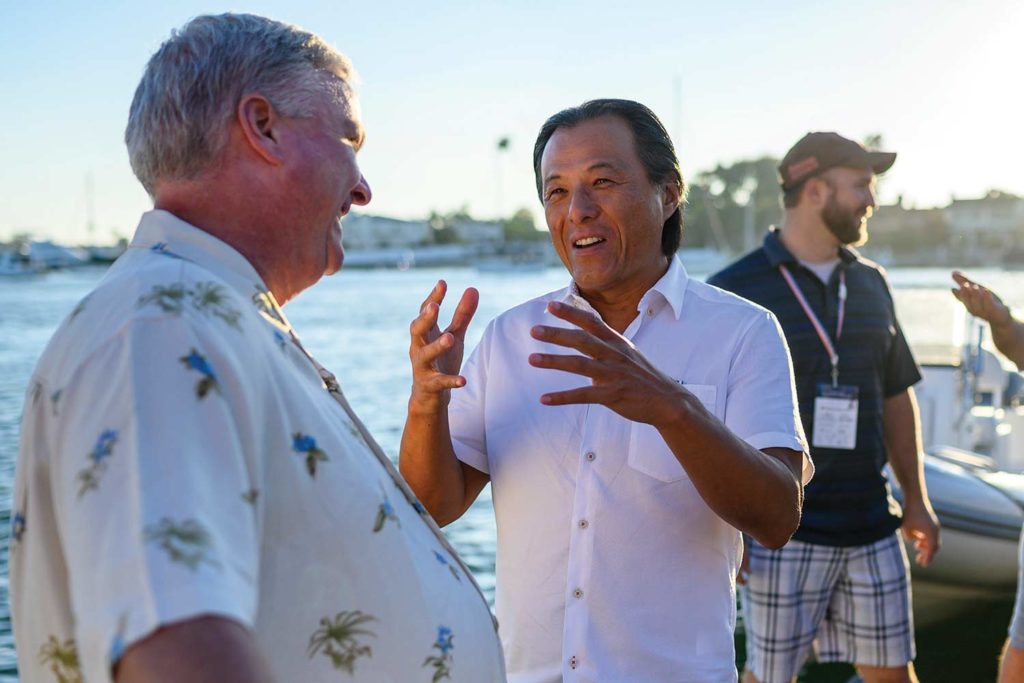
The day continued with nonstop activity—we saw at least 30 striped marlin—including four of them tailing in a row right alongside the boat. With Bad Company’s longtime mate, Elisio Herrera, also spotting fish from the tower, Lassley maneuvered into position for Hsieh to make his casts.
Of the fish we saw that day, we hooked four and caught two, with Brian Lee, vice president of Hsieh’s company, LoanDepot, landing his very first billfish, something I’m sure he will never forget. This might be considered a successful day of fishing for most people, but not for team Bad Company. Lassley couldn’t help himself, and immediately he began to analyze the day’s fishing, hoping to increase the hookup ratio the following morning.
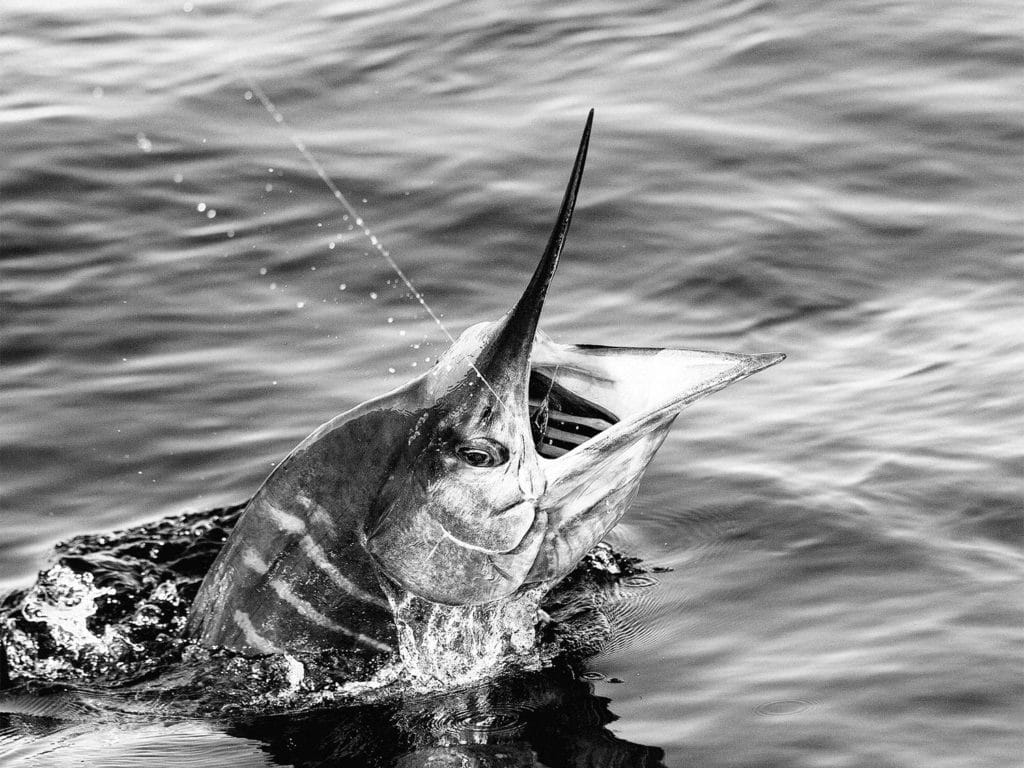
A Love of the Sea
Hsieh is first and foremost an innovative entrepreneur who has been in the home mortgage industry for over 30 years. After selling his last business to LendingTree, Hsieh saw the need for a tech-enabled consumer lender that offered something different than the banks and lenders at the core of the mortgage crisis. As the internet took off and with the future of online lending beginning to grow, Hsieh created LoanDepot; today, the company is considered the second-largest nonbank lender in the United States.
At the age of 8, Hsieh came to the United States with his parents from China. He was forced to learn the English language, worked hard, and is a self-made billionaire today at 54. Although he has an innate business sense, he also fell in love with the sea. He worked on the overnight sportboats when he was in high school—tying hooks, chumming, and cleaning fish for 25 cents each. He learned the basics of offshore fishing and bought his first boat while still a teenager: a 17-foot Boston Whaler that he trailered down to Baja.
As his knowledge grew, so did the size of his boats. During those early days on the docks, Hsieh met several captains he admired: Mike “The Beak” Hurt, Pete Groesbeck, Tony Nungaray, Joe Mike Lopez and Steve Lassley, among others. And all of them had one thing in common: They were sight-fishermen.
This Is Bad Company
“All of these guys are pretty special to me,” Hsieh says. “Ron [Ashimine, friend and teammate for over 35 years] and I have been fishing together since the mid-1980s. We met through business and became friends, so I invited him to fish with me,” he remembers. “We fished on my first diesel boat, a 32-foot Blackfin, and caught stripeys off Red Hill for hours. We came back to Cabo, cleaned the boat, and went to a great dinner that evening. It was a perfect day.” Since that day, Ashimine was an integral part of the Bad Company team, until his death in July 2019.
Joe Mike Lopez runs Hsieh’s 144-foot Bad Company. “Joe Mike? I’ve looked up to him and admired him since I was a kid,” Hsieh says. “His work ethic is phenomenal, and he’s really been a great asset to our program. I recall watching him backing in to the scales in Cabo on the 78-foot Norlund Kelly Anne. He backed the boat through Marina Cabo San Lucas, right to the scale, and weighed a 652-pound blue marlin during one of the Bisbee’s Black and Blue tournaments. It was so much fun to watch, and I’ve never forgotten it.
“When I heard Joe Mike was available, I called him right away and asked him to join the Bad Company program,” Hsieh continues. “Joe Mike is one of my few heroes and has been for years. He, like the others, had been ‘bitten by the bug’ at an early age, and has spent a lifetime building a résumé that was a perfect fit for us.”
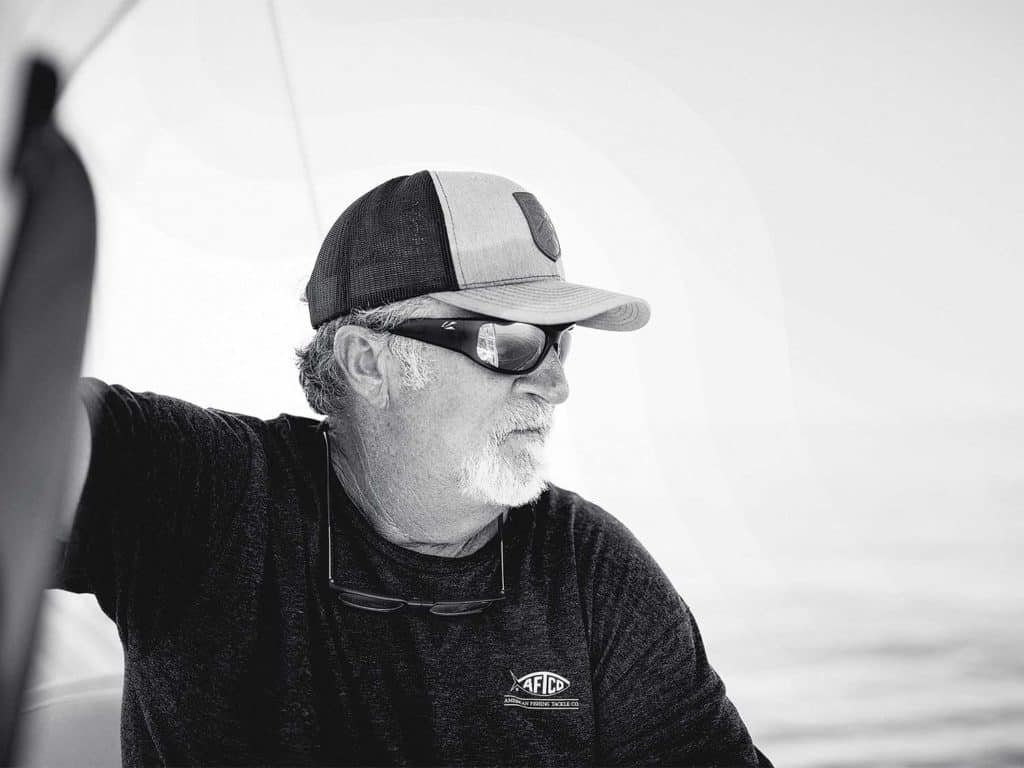
Capt. Steve Lassley has been with Hsieh’s Bad Company longer than anyone, except for Herrera, who has been part of the team since 1997. Lassley started fishing in his early teens and has been working on boats since he was 15. Shortly after his high school graduation, he obtained his commercial swordfish license, and his own boat followed at 19. The Southern California swordfishery is based entirely on sight-fishing, using only binoculars and satellite imagery to find the sunning swords—that’s where Lassley cut his teeth. By adding sonar and bottom-structure evaluation into the mix, Lassley and his swordfishing cohorts honed that style of fishing, which requires a tremendous amount of patience.
In 2004, Hsieh hired Lassley, who was one of the only captains who matched his style of fishing. As the stars aligned, Lassley became the team innovator, guiding Bad Company to win the largest jackpot at the time at the 2006 Bisbee’s Black and Blue Tournament: $3.9 million. The team also swept three other tournaments that year, with unprecedented winnings in excess of $4.3 million —the team’s hard work was finally paying off.
“Steve is my ‘fishing wife,’” Hsieh says. “I’ve never added up the hours, but I’ve probably spent more time with this human than anybody else in my life—male or female.” When you’re sight-fishing, you sit next to your captain, looking through the binoculars and working as a team. “It’s just like we’re married; we never talk!” Hsieh says with a laugh. “I do like to fish from the cockpit sometimes for big blue or black marlin, but I prefer sight-fishing: going forward, looking ahead, hunting for fish. I guess that’s what’s exciting to me.”
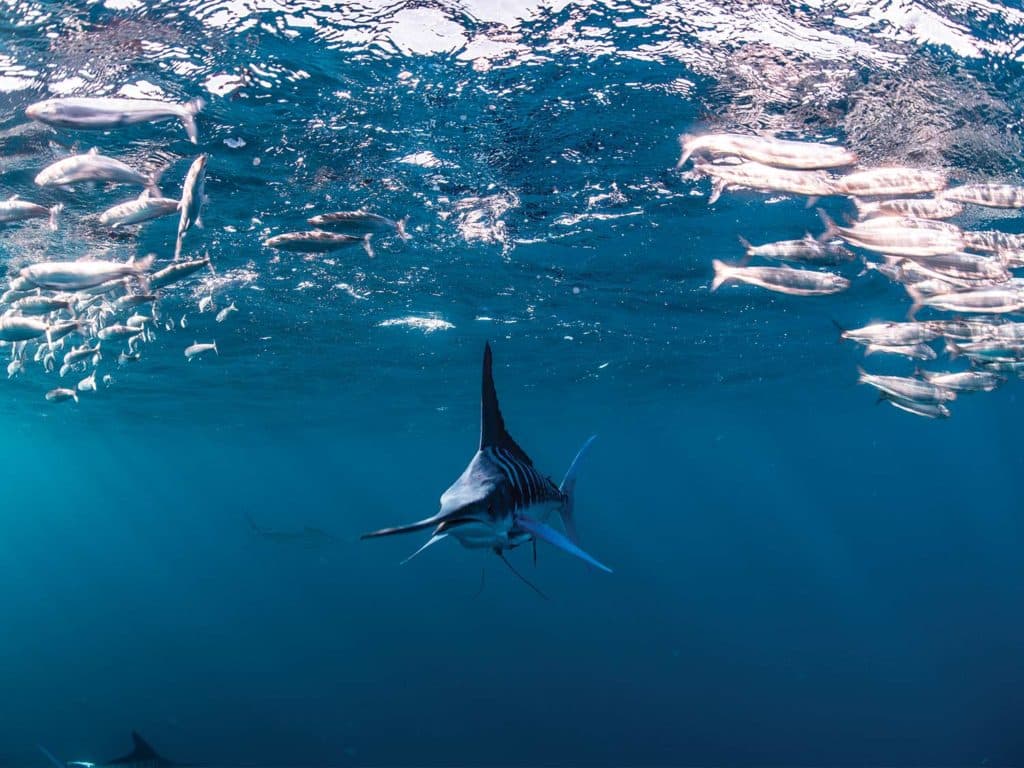
Big-Boat Billfish
The idea of fishing on structure was implanted in Lassley’s brain at a young age when he read an article by Capt. Bart Miller. “In the early 1970s, Miller stated there were ‘feeding stations’ in the ocean, and my wheels started spinning,” Lassley says. Bad Company always tries to be on the cutting edge of technology to help them find those spots where the fish will be; says Lassley: “How cool is it that in this vast ocean, there are places like that, and if you go back to those spots again with the same conditions, currents and winds, you’ll find fish in those exact spots?”
What Lassley is really trying to do is shrink down the ocean into smaller areas, targeting the spots that hold fish. “All the technology available today—sonar, fathometers, sea-surface temperature and current charts, chlorophyll, altimetry, coupled with a good plotter—really gives you a clear picture of the conditions and areas that produce fish,” Lassley says. “The trick is to be able to find the big ones when you’re fishing tournaments, and meat when you have guests on board.”
But even with all the technology, there are lots of times when “the fish just don’t show up, and that’s when the guys who drag ballyhoo make us look bad,” he admits. “But it’s the presentation and hunting that I enjoy so much. It truly is a combination of hunting and fishing.” Lassley says it’s the long-term team development—precision casting and boat maneuvering—that pays off. “We don’t even need to talk. I know exactly what Anthony is going to do, and he knows what I’m doing. It’s basically zero communication.”
In October 2014, Bad Company accomplished something that hadn’t been done in Southern California since 1931. At the time, El Niño conditions were pushing warm water up the coast, and anglers were catching fish that normally wouldn’t show up off the Southern California coast, like wahoo and blue marlin. Hsieh and Lassley planned a trip out of Newport Beach, specifically to target blue marlin. Lassley had found a nice piece of water using Ocean Imaging—his satellite-image provider of choice—and within 40 minutes of fishing, they hit pay dirt halfway between the islands of Catalina and San Clemente. The Bad Company team landed a 462-pound blue in those Southern California waters; rumor has it that it was only the second ever taken there.
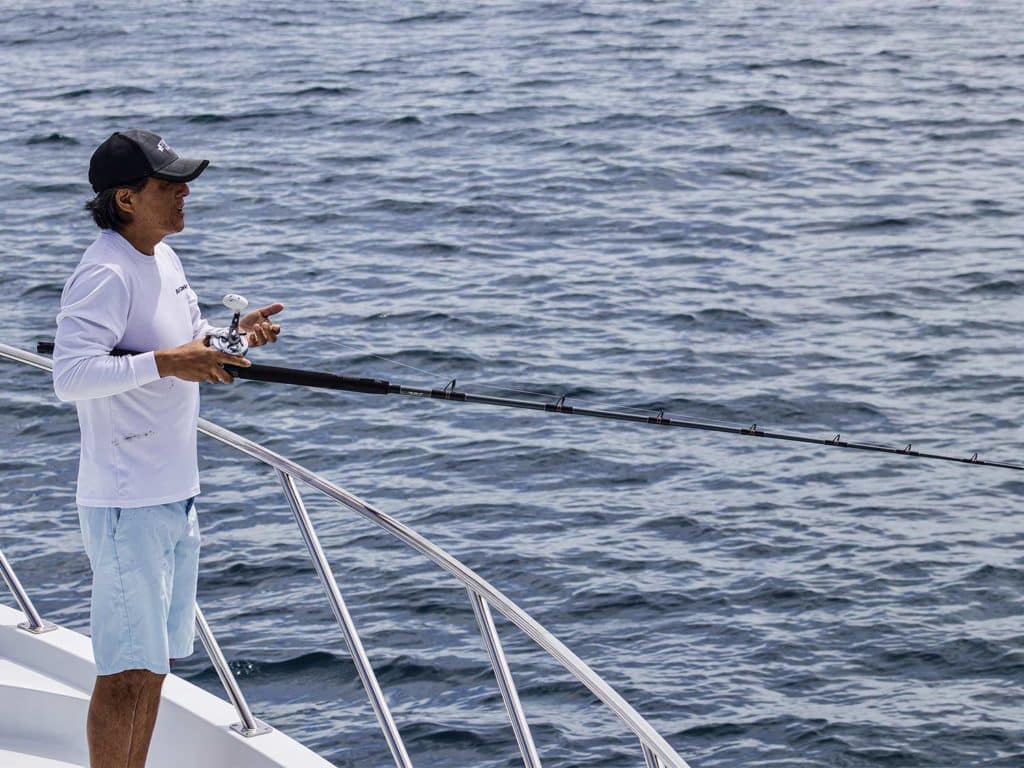
Swordfish Insight
“Visual swordfishing is by far, for me, the most exciting fishery there is. They’re just weird. We watch these fish with their huge bills, trying to attack a bait, and they’ll go crazy, clumsily darting about, getting so frustrated. But their bills are deadly,” Lassley says.
“There was a day at the Santa Cruz Islands when we tried to bait a finning swordy,” Lassley remembers. “This fish knocked two baits off the hook, then wouldn’t even look at another one, so we harpooned him.” When they cleaned the fish, the mackerel were in its stomach. “The swordfish had struck the jugular vein under the baits’ throats with surgical precision. There wasn’t another mark on their bodies. The swordfish had killed each one, knocking them off the hook before eating them both. This is no dumb fish.”
Hsieh expands: “These mackerel are swimming at Mach speed, and a swordfish can kill a bait just that precisely. It’s really amazing!”
Hsieh has learned a few tricks to getting Willy—his nickname for swordfish—to eat a live bait. “The success comes when we properly execute: Match the tackle precisely, position the boat, and then make the perfect cast,” Hsieh says.
Lassley adds: “You really have to make the bait appealing, and Anthony knows exactly what to do. Getting one bite out of eight to 10 shots on a swordfish is pretty typical here on the West Coast, and we’re getting one out of three to bite.”
“Willy is the weirdest, most powerful, most mysterious billfish there is, in my opinion. I’ll be standing on the pulpit, casting off the bow, and I’ll get them up to the boat, sometimes right under my feet, and they’ll turn on their side, looking directly up at me with that huge eye—like they’re trying to communicate. Or maybe trying to kill me,” Hsieh says. “But when they’re chasing a bait, they literally look like they’re falling all over themselves. Persistence and execution are the keys to swordfishing; the majority aren’t going to find the bait, so you really have to make it very attractive.”
To give you an idea of how difficult swordfish can be, Hsieh has cast to over 300 of them in his career—hooking 26 and landing only seven.
I ask Hsieh what the future holds for Bad Company. “We’ve all but stopped fishing in money tournaments years ago, and now fish just for fun. We have plans to take the boats to the South Pacific,” he says. “We will fish Mag Bay again as well. The striped marlin fishing there continues to be incredible.”
The team plans to put its sight-fishing methods to the test with a two-year tour that includes the Wanganella Bank (off New Zealand), Vanuatu, Tonga and Australia’s Great Barrier Reef.
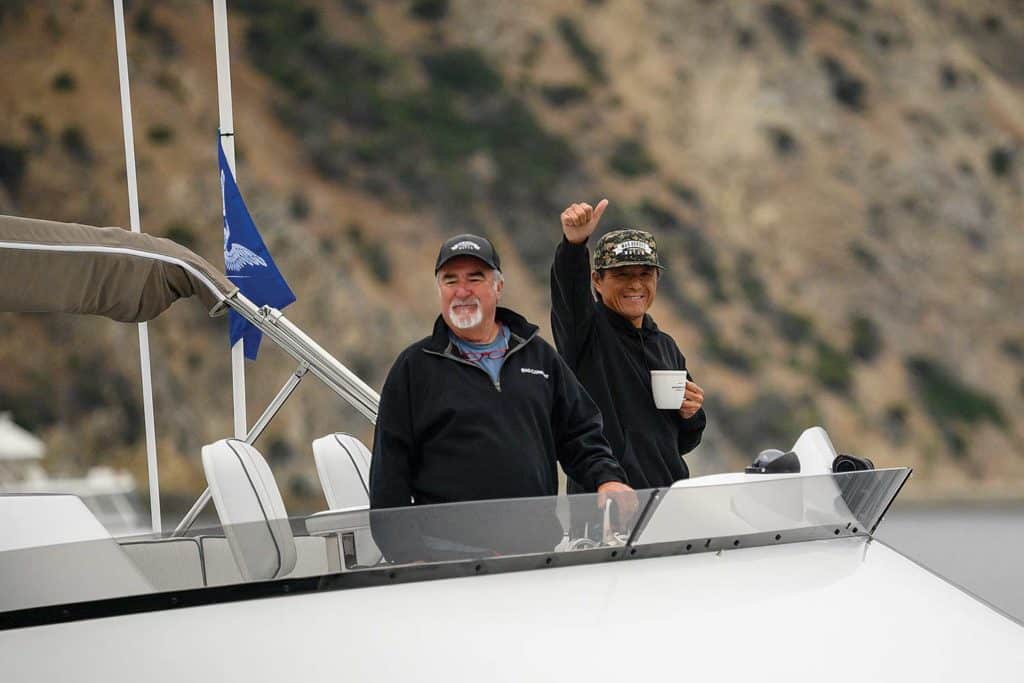
For the Heroes
What started as a social media post took on a life of its own in 2018. Hsieh decided to honor wounded war veterans by hosting a three-day fishing tournament with Freedom Alliance, a charitable organization that helps promote the event and distribute proceeds to injured war veterans and their families. Freedom Alliance has awarded more than $13 million in college scholarships to the children of military heroes who were killed or disabled in war. It has also contributed millions more by assisting injured veterans and their families with outdoor recreational-therapy trips, care packages for deployed troops, all-terrain wheelchairs, heroes’ vacations, and mortgage-free homes.
The inaugural War Heroes on Water tournament hosted 27 US military veterans in 2018, fishing on 11 of the top sport-fishing boats in Southern California, with the awards dinner held aboard Bad Company on the last evening.
Hsieh and his employees spend countless hours organizing the event, procuring items and trips for the silent auction, and handling the various details required to accommodate as many as 300 people at the opening reception, which is held at Hsieh’s home in Newport Beach. The 2018 silent auction raised over $90,000 for Freedom Alliance, and in 2019, the event hosted 50 veterans aboard 18 participating yachts, raising a half-million dollars.
The unique WHOW event has veterans spending the first day learning about the targeted species—calico bass, rockfish, yellowtail, yellowfin tuna, bluefin tuna, dorado, striped marlin and swordfish—and the techniques to catch each, while the next two days are hardcore, competitive fishing.
“Our goal is to give these brave and selfless heroes the weekend of a lifetime, but as it turns out, that’s also what they give us in return,” Hsieh says. “I am confident that every person who has participated in this tournament returns changed in a very profound way. The event is uplifting and joyful, and yet deeply emotional. It’s that special.”
For more information, to volunteer your boat or to make a donation, please contact War Heroes on Water tournament director Rod Halperin at [email protected].







